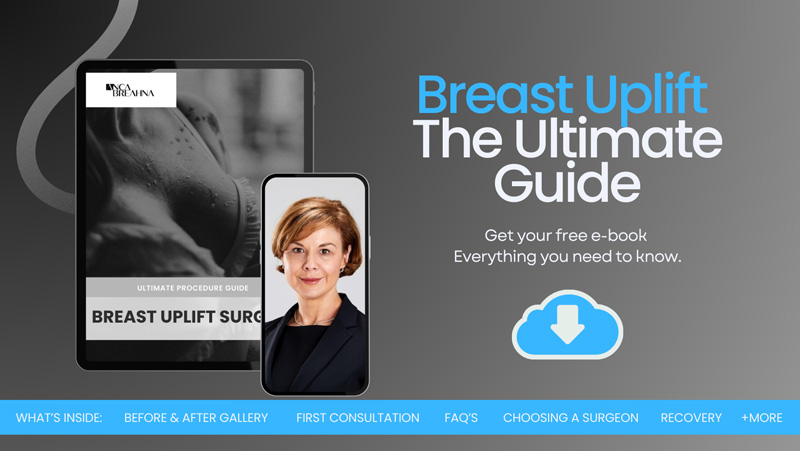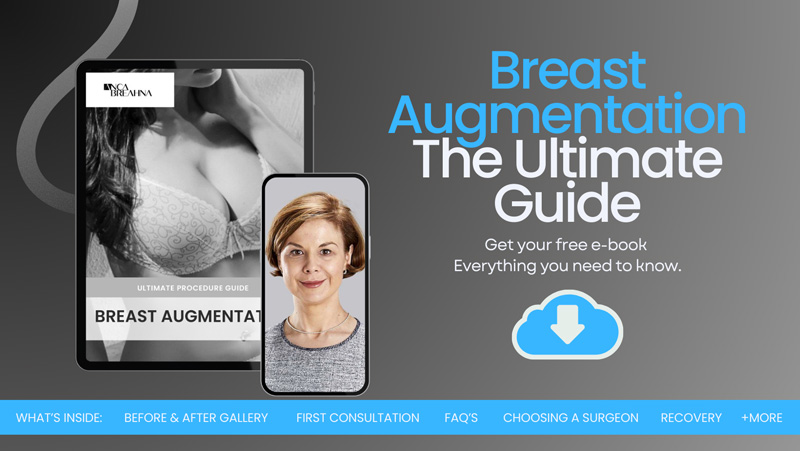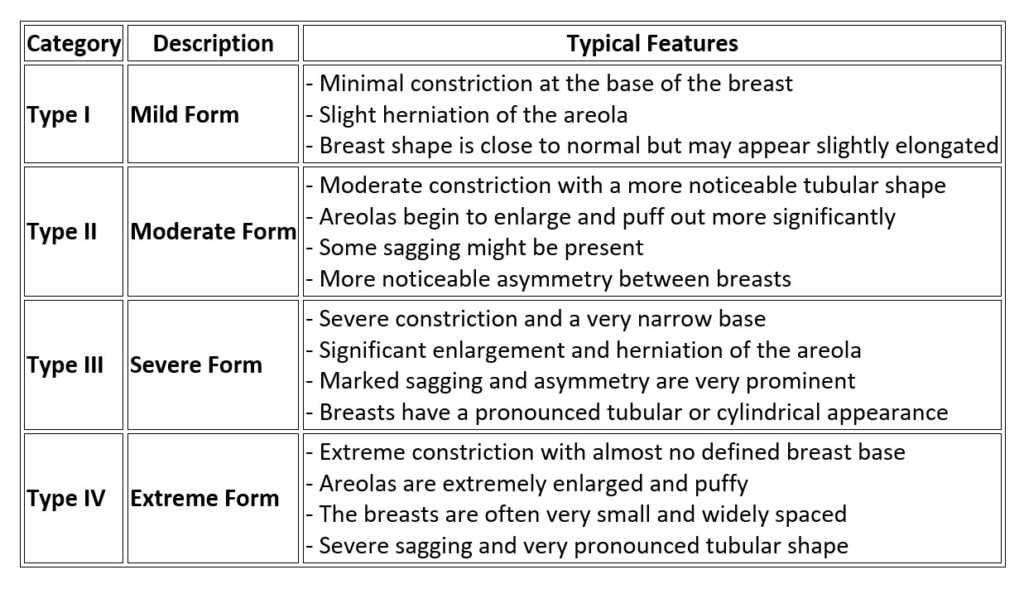
A Guide to Addressing Tuberous Breast Condition
Tuberous breasts are a developmental condition where breasts don’t form during puberty. This can result in breasts that look elongated or constricted at the base, creating a droopy appearance. The severity and shape can differ widely from person to person. While it’s not a rare condition, many are unaware of it until a formal diagnosis is made.
The signs of tuberous breasts can vary but usually include a higher than usual breast fold, a narrow base of the breast, and areola enlargement. These features might develop on one or both breasts and can lead to asymmetry.
If you’re feeling overwhelmed by the challenges associated with tuberous breasts, Consultant Plastic Surgeon Anca Breahna offers expert and compassionate care tailored to your unique needs. As a seasoned professional in cosmetic and reconstructive breast surgery, Anca Breahna understands the complexity of tuberous breast correction and is dedicated to providing solutions that not only improve aesthetics but also enhance your comfort and confidence.
Take our Plastic Surgery Quiz to find out if you’d be a good candidate for cosmetic surgery.
Diagnosing Tuberous Breasts
Diagnosing tuberous breasts usually involves a physical exam and possibly imaging tests like a mammogram or ultrasound to look at the underlying breast structure. Anca will look for typical features of the condition, such as breast asymmetry, narrow base width, and herniation of the areola complex.
It is important to seek a diagnosis from a qualified healthcare provider who can offer a complete evaluation. This ensures that any decision made regarding potential treatments or surgeries is based on accurate and thorough medical advice.
Identifying tuberous breasts early can significantly improve the effectiveness of treatments. Early diagnosis provides more options for managing the condition, potentially with less invasive procedures and more time for planning if surgical options are considered.
Key Characteristics of Tubular Breasts
These features contribute to the unique appearance of tubular breasts, and while they vary from person to person, these are the commonly observed characteristics.
- Narrow Base: The breast tissue is constricted at the base, making the breasts appear more narrow or tube-like than rounded.
- Spacing Between Breasts: There is often a wider than usual gap between the breasts due to the constricted base.
- Puffy Areolas: The areolas may appear unusually large or puffy because breast tissue herniates into the areola.
- Sagging: The breasts may sag or hang, which is unusual in younger women without a history of significant weight change or pregnancy.
- Asymmetry: One breast may be noticeably different in size or shape compared to the other.
- Minimal Cleavage: Due to the narrow base and spacing, creating cleavage can be difficult even with supportive bras.
- Heightened Breast Fold: The fold under the breasts (where the breast meets the chest wall) might be higher than normal.
Many people first notice these traits and wonder if they have tuberous breasts. Do You Have Pointy Boobs? They Could Be Tuberous Breasts dives deeper into understanding these features.
Classifying Tubular Breasts
Tubular breasts vary not only in appearance but also in the degree of physical manifestation, which impacts the choice of corrective procedures. The following table categorises tubular breasts into four distinct types. Each category is defined by specific characteristics such as the degree of base constriction, areola size and herniation, and overall breast shape and symmetry.
Here is a table describing various categories of tubular breasts, which typically differ based on the degree of severity and specific physical characteristics. This classification can help in understanding the condition better and discussing potential treatment options more effectively:
Treatment Options for Tuberous Breasts
It is important to understand that this condition does not affect your health but can cause significant emotional and psychological discomfort due to its unusual appearance. The treatment for tuberous breasts is purely cosmetic, aimed at improving the breast shape and symmetry to align more closely with conventional aesthetic norms. One of the most common methods to correct this condition is through surgical intervention, such as breast augmentation.
Breast Augmentation with Implants
This is the most popular surgical option for correcting the shape of tuberous breasts. Silicone or saline implants are inserted to create a fuller look and a more rounded shape. This procedure helps in expanding the base of the breast, reducing the tubular appearance significantly.
- Procedure Overview: Typically involves a one to three-hour surgery under general anaesthesia.
- Recovery: You can return to work within a week but should avoid strenuous activities for up to six weeks.
Breast Uplift (Mastopexy)
A breast uplift can be performed in conjunction with implants to raise sagging breasts and reposition the nipples to a more natural-looking height relative to the newly shaped breasts.
- Procedure Overview: Excess skin is removed, and breast tissue is reshaped to raise the breasts. This can also include resizing the areolas to make them proportionate to the new breast size.
- Recovery: Recovery timelines are similar to breast augmentation, with you resuming normal activities within a week under proper care.
Download the Breast Uplift Guide

Fat Grafting
For those who prefer a less invasive option than implants, fat grafting involves taking fat from another part of the body (like the abdomen or thighs) and injecting it into the breast area. This helps in smoothing out any irregularities and achieving a more natural augmentation.
- Procedure Overview: This procedure is generally less invasive than implant surgery and can be done under local anaesthesia.
- Recovery: You can usually resume daily activities within a few days, although swelling and bruising may last for a couple of weeks.
Areolar Reduction
Many individuals with tuberous breasts have enlarged areolas. Areolar reduction surgery can be done to reduce the diameter of the areolas and improve overall breast aesthetics.
- Procedure Overview: This surgery can often be completed in less than an hour and is sometimes combined with other procedures like a breast lift.
- Recovery: Recovery is relatively quick, with you resuming normal activities within a few days to a week.
These surgical options provide various ways for women to address the aesthetic concerns caused by tuberous breasts. It is important to consult with Anca who has experience in treating this specific condition to discuss the most suitable option based on you needs and desired outcomes.
Preparing for Surgery
Before surgery, a detailed consultation with Anca will take place. During this session, you should discuss your expectations, potential risks, and the surgical process. This is the time to ask all the questions you have regarding the procedure.
Being well-prepared for surgery includes understanding all aspects of the procedure, recovery, and expected results. This preparation can help alleviate any concerns and increase your comfort level with the decision to proceed.
The Surgical Procedure
Understanding the surgical steps can help you feel more prepared and reduce any apprehension you might feel about the operation:
- Anaesthesia: The procedure is typically performed under general anaesthesia, meaning you will be asleep throughout the operation and won’t feel any pain. An anaesthesiologist will be present to monitor your vitals and ensure you remain comfortable and safe.
- Resizing the Breast Base: One of the primary goals of the surgery is to correct the constricted breast base characteristic of tuberous breasts. This involves surgical incisions around the base to release the tight tissue and allow for a more natural, rounded breast shape.
- Reshaping the Tissue: After addressing the base, the next step is to reshape the existing breast tissue to achieve a more aesthetically pleasing and symmetrical appearance. This may involve redistributing the tissue or possibly removing some tissue to improve contour and symmetry.
- Correcting Nipple and Areola Position: For many patients, the position and size of the nipples and areolas are also adjusted during the surgery. This can include reducing the size of the areolas and repositioning the nipples to a more central location on the breasts to match the newly shaped breasts.
- Closing the Incisions: The incisions are then carefully closed with sutures, often placed in a way to minimise visible scarring. Anca will use techniques aimed at promoting the best possible healing and aesthetic outcome.
Immediately after the operation, managing pain and preventing infection are top priorities. You will receive medications for pain relief and instructions on how to care for the surgical site at home. Regular check-ups with Anca will ensure that the recovery is on track and any complications are addressed swiftly.
Recovery from breast surgery can take several weeks, during which strenuous activities should be avoided. The timeline for returning to daily activities varies; however, most find that they can resume routine tasks within a few weeks with gradual improvement in surgical areas.
Download the Breast Augmentation Guide

FAQs about Causes and Treatments for Tuberous Breasts
What are the risks associated with surgical treatment for tuberous breasts?
- Like any surgical procedure, treatments for tuberous breasts carry certain risks. Common risks include reactions to anaesthesia, blood clots, infection, and scarring. Specific to breast surgery, there might be issues with breast symmetry, sensory changes in the breast or nipple, and a potential need for revision surgery in the future. Discussing these risks with Anca can help you make an informed decision based on a thorough understanding of potential complications.
Can tuberous breasts be corrected without surgery?
- Non-surgical options for managing the appearance of tuberous breasts are limited and generally not as effective as surgical interventions. Some people might explore options like hormonal therapy or use special bras for cosmetic purposes to alter the breast’s appearance temporarily. However, for permanent and significant changes, surgical procedures are typically necessary.
How do I choose the right surgeon for my tuberous breast correction?
- Choosing the right surgeon is critical. Look for a consultant plastic surgeon with specific experience in treating tuberous breasts. You can ask for before-and-after photos of previous patients with similar conditions, read reviews, and consider having initial consultations with multiple surgeons to compare their approaches and recommendations.
Are the results of tuberous breast surgery permanent?
- The results of surgeries like breast augmentation, lift, or reduction are generally long-lasting, but they are not considered permanent. Natural ageing, weight fluctuations, and hormonal changes can all affect the shape and size of breasts over time. Regular follow-ups with Anca and maintaining a stable weight can help prolong the results.
Further Reading about Breast Surgery with Consultant Plastic Surgeon Anca Breahna
- Read more about How to Choose the Best Breast Implant Profile and Projection
- Read more about How to Fix Saggy Breasts – Breast Uplift, Breast Implants or Both
- Read more about What is Breast Augmentation Surgery?
- Read more about All about Perfect Breasts and How to Get Them
- Read more about What Are Pointy Breasts or Puffy Nipples?
Medical References about Causes and Treatments for Tuberous Breasts
- The tuberous breast deformity: classification and treatment – Science Direct
- Tuberous Breast Management -NCBI
- Review of Tuberous Breast Deformity – PubMed
- Tubular breasts: Symptoms, causes, and augmentation – Medical News Today
- Tubular Breasts: What They Are, Causes & Treatment Options – Cleveland Clinic



 Ms Anca Breahna, PhD, MSc, FEBOPRAS, FRCS (Plast) is a highly regarded Consultant Plastic Surgeon specialising in the field of Aesthetic and Reconstructive Plastic Surgery. Anca performs a range of
Ms Anca Breahna, PhD, MSc, FEBOPRAS, FRCS (Plast) is a highly regarded Consultant Plastic Surgeon specialising in the field of Aesthetic and Reconstructive Plastic Surgery. Anca performs a range of 